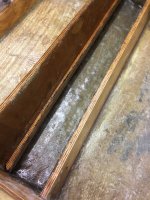So, I dove right in this afternoon. Of course I started with a difficult area for my first time glassing. I should have started with something more simple and easier to get at. I started with the engine mount "steps" on the starboard side. I laid glass on the tall stringer and then the short stringer with the 1708 overlapping on the floor of the hull. I ran into a few problems.
First the glass wanted to "pucker" at the top and bottom edge of the glass strip. I cut the point where it buckled up and overlap them. Don't know if that was correct. I think I caused the problem by allowing the edges to get stretched a bit. The problem occurred on both the tall and short stringer.
Second, I had the strips a little too long for the opening which meant they overlapped the transom and the bulkhead at each end. That created another "pucker" of too much glass at the corner. I again had to cut the buckled piece and overlap the ends.
Third, I added thickened resin to the board that supports the motor mount on the tall stringer. I had it beveled at 45 degrees on the underside and laid one piece of 1708 from the edge, then underside on the 45, across the hull, and up the inside of the short stringer. I layered the second layer of 1708 fairly soon after laying the first piece. When trying to roll it out with the serrated metal roller, it wanted to lift off the first layer of 1708.
Finally, I had problems getting the air bubbles out. I think that was because the hull wasn't smooth enough creating small pockets in places. It seemed the more I tried the work them out the worse it got. What a pain...





























